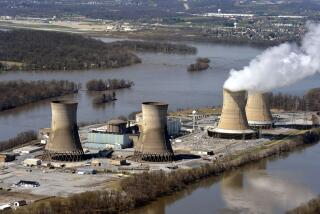Tritium Supply Called Enough for Defense Needs
- Share via
WASHINGTON — Despite the shutdown of all three of its weapons production reactors for safety reasons, the government has sufficient supplies of tritium, a key fuel in thermonuclear weapons, to meet current defense needs at least until 1990, according to federal officials and independent analysts.
These sources said that the government’s existing supplies of tritium probably can be stretched to last at least 18 months and probably longer without impairing the nation’s stockpile of nuclear weapons, which are believed to number about 22,000.
A decision by the Energy Department to close all three operable reactors at its Savannah River weapons production facility in South Carolina for safety modifications and to improve the training of reactor operators has stirred concern that the government may soon be forced to cannibalize some nuclear weapons to keep others in working order.
Disarmament Feared
Fears that the United States may face a form of unilateral disarmament as the price for neglecting the upkeep of its vast weapons production complex have surfaced in Congress and cropped up last week in the second presidential debate.
Federal officials, citing security reasons, have refused to specify when the government’s supply of tritium, a radioactive form of hydrogen gas, would fall to such a critical level. Because tritium decays radioactively at a rate of 5.5% a year, it must be replenished periodically to maintain a weapon’s explosive yield.
How often weapons must be recharged with tritium, and in what quantities, is something “we think the Russians don’t need to know,” one official noted.
In separate interviews, however, senior officials at the Defense Department and the Department of Energy said there was no danger of a tritium crisis this year or next, even if the DOE fails to restart any of the three Savannah River reactors next year. It now plans to have all three running by late next summer.
“We are talking about a medium-range problem, not an imminent one,” said a senior DOE official familiar with weapons production programs. The official, who asked not to be identified, said that if the Savannah River reactors fail to come back on line as now scheduled, the government risks “falling below the level of what we need in a couple years down the line,” but not in the immediate future.
Safety Improvements
Similarly, a Defense Department official who asked not to be identified said that while there is an urgent need to complete the safety improvements now under way at Savannah River, it would be inaccurate to suggest that a critical shortage of tritium could develop “in the next 12 months or so.”
“But looking down the road several years,” this official added, “then you are definitely in a situation when you have to take tritium from other weapons or find other sources.”
Under those circumstances, officials said, supplemental supplies of tritium could be obtained as a stopgap measure from Great Britain or France, both of which have their own weapons production reactors, or from Canada, which produces tritium although it does not have nuclear weapons.
Tritium is used to boost the power of nuclear weapons. Under the astronomical temperatures and pressures of a fission explosion, triggered in a weapon’s plutonium core, the tritium undergoes thermonuclear fusion, releasing still more energy in the form of neutrons, gamma rays, X-rays, heat and explosive force.
The addition of small amounts of gaseous tritium to a weapon--a few grams, according to published accounts--has enabled weapons designers to shrink the size and weight of warheads while maintaining their yield and in some ways “enhancing” their performance, in a term used by weapons designers.
Meant to Penetrate Armor
So-called neutron weapons, for example, would use tritium to produce a relatively large part of their yield in the form of neutrons, which are meant to penetrate the armor of massed Soviet tanks in the event of an invasion of Western Europe. The United States never has built such weapons.
Assertions by government officials that existing tritium supplies are sufficient for at least the next two years are consistent with estimates by some independent analysts.
One reason, these analysts and federal officials note, is that shutting down production reactors does not immediately stop the production of tritium, which is made by irradiating the lightweight metal lithium in the reactors. The government has a stockpile of previously irradiated lithium from which tritium is still being extracted, officials said; the size of this stockpile is classified.
More important, outside analysts note, just as it is unnecessary to fill a car’s gas tank to the top to keep it running, nuclear weapons do not need to be fully replenished with tritium to maintain their design performance.
Thomas B. Cochran, a staff scientist of the Natural Resources Defense Council--an environmental group regarded as one of the Energy Department’s most sophisticated antagonists--says that the government appears to have a nine-month reserve of tritium, which could be stretched to last 18 months or more.
Stored in Bottles
Tritium gas in nuclear weapons, Cochran said in an interview Monday, is confined in small, pressurized “bottles” that are removed every four or five years and sent to the DOE’s Mound Laboratory, run under contract by the Monsanto Research Corp. near Dayton, Ohio, to be recharged with tritium.
Because the tritium decays to inert helium gas at a rate of about 5% a year, this implies that 20% to 25% of a weapon’s supply is normally allowed to disappear, apparently without impairing its yield. If weapons are given only half their usual replenishment, Cochran notes, their yield would presumably be restored to acceptable levels for at least two years, and the government’s tritium reserve--estimated in published accounts as a nine-month supply--would effectively be doubled.
One of the three Savannah River units, known as the P reactor, was shut down last August after an unexplained power surge, and is not expected to be restarted until the third quarter of 1989.
A second unit, the K reactor, was closed last April for regular maintenance, improvements in its emergency cooling system and strengthening of its seismic bracing and is now scheduled to be restarted in December.
Jim Gaver, a DOE spokesman at Savannah River, said that the third unit, the L reactor, was stopped last June as it is every year because South Carolina environmental regulations require that its cooling lake remain below 90 degrees. “The sun alone is enough to heat it to that point,” Gaver said.
Restarting Delayed
Improvements in the reactor’s electrical system are expected to delay restarting it until the first quarter of next year.
Since a public furor over the safety of the three reactors first arose from a congressional hearing three weeks ago, the Energy Department has said that its own internal reviews have confirmed the findings of outside advisers that the quality of training and supervision of reactor operators at Savannah River has fallen below the standards now current in the civilian nuclear industry.
The Du Pont Co., which has run Savannah River under a government contract since the facility was established in 1950, has angrily rejected suggestions that its management of the facility was lax or antiquated. Staff writer John M. Broder contributed to this story.
More to Read
Sign up for Essential California
The most important California stories and recommendations in your inbox every morning.
You may occasionally receive promotional content from the Los Angeles Times.










